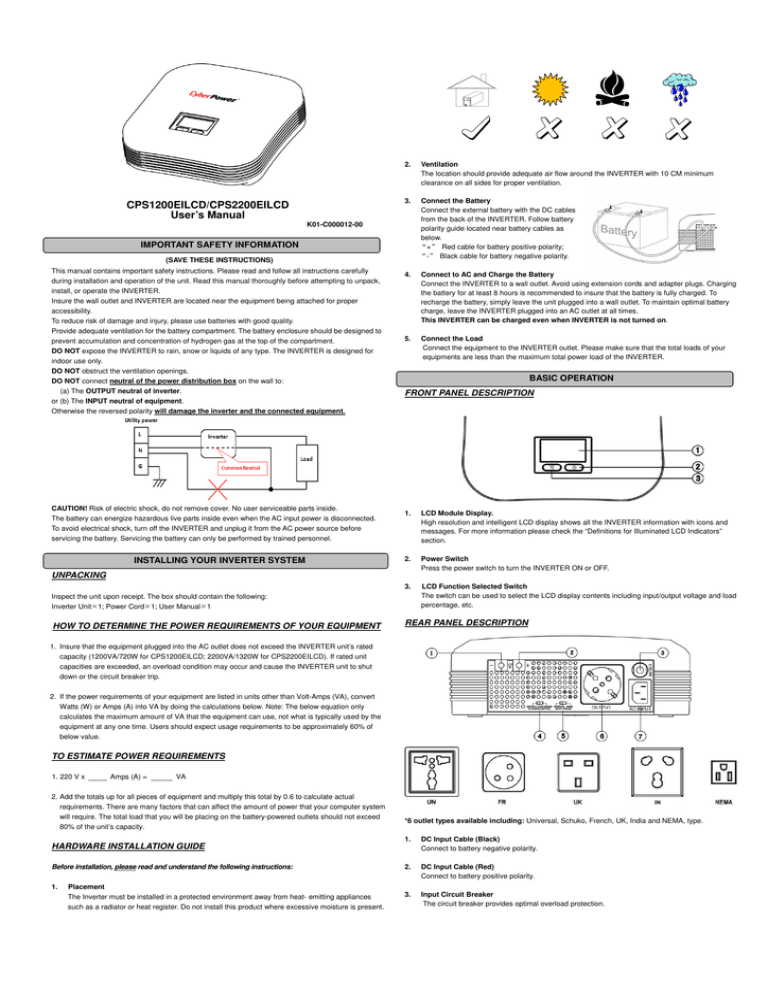
CPS1200EILCD/CPS2200EILCD
User’s Manual
2.
Ventilation
The location should provide adequate air flow around the INVERTER with 10 CM minimum
clearance on all sides for proper ventilation.
3.
Connect the Battery
Connect the external battery with the DC cables
from the back of the INVERTER. Follow battery
polarity guide located near battery cables as
below.
“+” Red cable for battery positive polarity;
“-” Black cable for battery negative polarity.
4.
Connect to AC and Charge the Battery
Connect the INVERTER to a wall outlet. Avoid using extension cords and adapter plugs. Charging
the battery for at least 8 hours is recommended to insure that the battery is fully charged. To
recharge the battery, simply leave the unit plugged into a wall outlet. To maintain optimal battery
charge, leave the INVERTER plugged into an AC outlet at all times.
This INVERTER can be charged even when INVERTER is not turned on.
5.
Connect the Load
Connect the equipment to the INVERTER outlet. Please make sure that the total loads of your
equipments are less than the maximum total power load of the INVERTER.
K01-C000012-00
IMPORTANT SAFETY INFORMATION
(SAVE THESE INSTRUCTIONS)
This manual contains important safety instructions. Please read and follow all instructions carefully
during installation and operation of the unit. Read this manual thoroughly before attempting to unpack,
install, or operate the INVERTER.
Insure the wall outlet and INVERTER are located near the equipment being attached for proper
accessibility.
To reduce risk of damage and injury, please use batteries with good quality.
Provide adequate ventilation for the battery compartment. The battery enclosure should be designed to
prevent accumulation and concentration of hydrogen gas at the top of the compartment.
DO NOT expose the INVERTER to rain, snow or liquids of any type. The INVERTER is designed for
indoor use only.
DO NOT obstruct the ventilation openings.
DO NOT connect neutral of the power distribution box on the wall to:
(a) The OUTPUT neutral of inverter.
or (b) The INPUT neutral of equipment.
Otherwise the reversed polarity will damage the inverter and the connected equipment.
CAUTION! Risk of electric shock, do not remove cover. No user serviceable parts inside.
The battery can energize hazardous live parts inside even when the AC input power is disconnected.
To avoid electrical shock, turn off the INVERTER and unplug it from the AC power source before
servicing the battery. Servicing the battery can only be performed by trained personnel.
INSTALLING YOUR INVERTER SYSTEM
BASIC OPERATION
FRONT PANEL DESCRIPTION
1.
LCD Module Display.
High resolution and intelligent LCD display shows all the INVERTER information with icons and
messages. For more information please check the “Definitions for Illuminated LCD Indicators”
section.
2.
Power Switch
Press the power switch to turn the INVERTER ON or OFF.
3.
LCD Function Selected Switch
The switch can be used to select the LCD display contents including input/output voltage and load
percentage, etc.
UNPACKING
Inspect the unit upon receipt. The box should contain the following:
Inverter Unit1; Power Cord1; User Manual1
HOW TO DETERMINE THE POWER REQUIREMENTS OF YOUR EQUIPMENT
REAR PANEL DESCRIPTION
1. Insure that the equipment plugged into the AC outlet does not exceed the INVERTER unit’s rated
capacity (1200VA/720W for CPS1200EILCD; 2200VA/1320W for CPS2200EILCD). If rated unit
capacities are exceeded, an overload condition may occur and cause the INVERTER unit to shut
down or the circuit breaker trip.
2. If the power requirements of your equipment are listed in units other than Volt-Amps (VA), convert
Watts (W) or Amps (A) into VA by doing the calculations below. Note: The below equation only
calculates the maximum amount of VA that the equipment can use, not what is typically used by the
equipment at any one time. Users should expect usage requirements to be approximately 60% of
below value.
TO ESTIMATE POWER REQUIREMENTS
1. 220 V x
Amps (A) =
VA
2. Add the totals up for all pieces of equipment and multiply this total by 0.6 to calculate actual
requirements. There are many factors that can affect the amount of power that your computer system
will require. The total load that you will be placing on the battery-powered outlets should not exceed
80% of the unit’s capacity.
*6 outlet types available including: Universal, Schuko, French, UK, India and NEMA, type.
1.
DC Input Cable (Black)
Connect to battery negative polarity.
2.
DC Input Cable (Red)
Connect to battery positive polarity.
3.
Input Circuit Breaker
The circuit breaker provides optimal overload protection.
HARDWARE INSTALLATION GUIDE
Before installation, please read and understand the following instructions:
1.
Placement
The Inverter must be installed in a protected environment away from heat- emitting appliances
such as a radiator or heat register. Do not install this product where excessive moisture is present.
4.
Charger Control*
A. Select “Default” setting for general application. The charge voltage is 13.7V, 27.4V
respectively for CPS1200EI and CPS2200EI.
Battery voltage is too
low.
Charge battery for 8 hours
or more.
If any abnormal situations occur that are not listed above, please contact service personnel.
B. Select “Customized” setting for special battery condition. The charge voltage is 13.3V, 26.6V,
respectively for CPS1200EI and CPS2200EI.
*Note: Operate by trained professionals ONLY. Incorrect operation will damage the battery.
5.
Input Voltage Range Selector
Input voltage range is defined in specification section. Output voltage is the same as input voltage
in AC mode.
A. Select “Narrow” setting for general electrical appliance such as TUBE LIGHT, ENERGY
SAVING LAMP, TV, JUICER & MIXER etc. It is not suitable for high-power motor or inductive
load, such as the fridge of 1KW, the motor of 800W, AIR COOLER(having risk of rebooting)
and so on. In this mode, the INVERTER operating voltage in AC mode is within 190~ 260Vac
with the same output voltage. The line sensitivity is higher.
B. Select “Wide” setting to save energy. In this mode the operating range of voltage for the
INVERTER is 100-280Vac. Therefore the output voltage will be the same as the MAINS input
voltage. The INVERTER unit in this mode has a lower sensitivity with a longer transfer time for
switching from AC mode to battery mode in the event of power failure. You can safely connect
and use home appliances which are not sensitive to transfer time limitations such as florescent
tubes, bulbs, TV etc.
TECHNICAL SPECIFICATIONS
Model
CPS1200EILCD
CPS2200EILCD
1200VA
2200VA
720W
1320W
Capacity (VA)
Capacity (Watts)
Input
Input Voltage Range
Wide mode: 100VAC-280VAC
Narrow mode: 190VAC-260VAC
Frequency Range
50/60Hz
Output
On Battery Output
Voltage
Simulated Sine Wave at 220Vac +/-10%
On Battery Output
Frequency
50/60Hz
Overload Protection
On Utility: Circuit Breaker, On Battery: Internal Current Limiting
Physical
6.
AC outlet**
The INVERTER provides one outlet for connected equipment to insure temporary uninterrupted
operation during a power failure and against surges and spikes.
**Note: 6 outlet types available, including Universal, Schuko, French, UK, India and NEMA, type.
Total # of INVERTER
Receptacles
(1) Shuko/FR/UK/India/NEMA/UN
Maximum Dimensions
265mm(L)* 250cm(W)* 90cm(H)
Weight
7.
2.05 kg / 4.5 Lbs
2.2 kg / 4.9 Lbs
12V
24V
Battery
AC Inlet
Connect to utility power through the input power cord.
Lead Acid Battery
Warning Diagnostics
Functional Test
Indicators
AC Mode
Audible Alarms
The INVERTER delivers power to the load derived from the utility and maintains proper battery charge.
Environmental
On-Battery Mode
The INVERTER operates on battery when the utility voltage has fallen outside the limits. Local users are
alerted to this mode of operation by visual and audible indicators. The INVERTER provides power to the
load from the battery and the output voltage of the INVERTER are regulated within a narrow range
1.
Switch On
Press the power switch then the status LCD will light up.
2.
Switch Off
Press again the power switch, the status LCD will go off.
INVERTER Status Display,
Low Battery, Overload, Fault
Operating Temperature
+32°F to 104°F ( 0°C to 40°C )
Operating Relative
Humidity
0 to 90% NON-CONDENSING
Management
Auto-Charger
Yes
Auto-Restart
Yes
DEFINITIONS FOR ILLUMINATED LCD INDICATORS
3.
LCD Indication
Cold Start / Start on Battery:
This INVERTER can be turned on even when AC is not present.
Press the power switch then the status LCD will light up.
ROUTINE MAINTENANCE AND STORAGE
ROUTINE MAINTENANCE
1.
Use dry soft clothes to clean the panel and plastic parts. Do not use any detergent that contains
alcoholic ingredient.
2.
Unplug the INVERTER from power inlet if the INVERTER will not operate for long period of time.
STORAGE
1.
First turn off your INVERTER and disconnect its power cord from the wall outlet. Disconnect all
cables connected the INVERTER to avoid battery drain.
Line mode
INVERTER Status
Display
Select SW
Press
Initial
1st
2nd
(Overload)
“V” : Illuminated,
V
V
V
V
X
X
X
X
X
X
X
X
Capacity Display
---V
“X” : Not Illuminated,
Load
Cap.
X
V
X
--
Battery
Cap.
V
X
V
--
Digital Value Display
Input
Voltage
Output
Voltage
V
%
of Load
V
V
--
--
--
“--“ : Either
Battery mode
2.
The INVERTER should be stored in a cool dry location.
3.
Make sure the battery is fully charged before the INVERTER is stored.
4.
For extended storage in moderate climates, the battery should be charged for 12 hours every 3
months by plugging the power cord into the wall receptacle and turning on the main switch. Repeat
it every 2 months in high temperature locations.
TROUBLE SHOOTING
Problem
No LCD display
Possible Causes
Initial
1st
2nd
Press >3sec
(Sound Disable)
Press >3sec
again
(Sound Enable)
(Overload)
“V” : Illuminated,
Remedy
1. Battery Weak
1. Re-charge battery
2. Battery defective
2. Battery replacement.
3. Power switch is not
pressed
3. Press and hold power
switch.
1. AC Input missing
1. Check AC input
connection.
2. Input protector is effective
2. Reset the input protector.
Alarm buzzer beeps
continuously
Overload
Verify that the load
matches the capability
specified in the specs.
Backup time is shortened
Overload
Remove some non-critical
load.
Mains normal but not
works in AC mode
INVERTER Status
Display
Select SW
Press
Digital Value Display
Capacity Display
Load
Cap.
Battery
Cap.
Input
Voltage
Output
Voltage
%
of Load
X
X
X
V
V
V
----
----
X
V
X
V
X
V
V
X
V
V
--
--
--
--
--
--
X
V
X
--
--
--
--
--
--
X
V
--
V
--
--
--
--
--
“X” : Not Illuminated,
V
V
“--“ : Either
Off charging mode (Auto bypass)
INVERTER Status
Display
Select SW
Press
Initial
“V” : Illuminated,
V
X
X
Capacity Display
X
“X” : Not Illuminated,
Load
Cap.
X
Battery
Cap.
X
Digital Value Display
Input
Voltage
X
Output
Voltage
X
%
of Load
X
“--“ : Either
Visit www.cpsww.com for more product information and the nearest CyberPower local contact for your
region.
Entire contents copyright ©2012 CyberPower Systems, Inc All rights reserved. Reproduction
in whole or in part without permission is prohibited.





